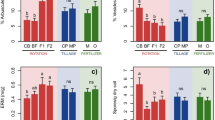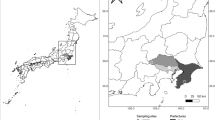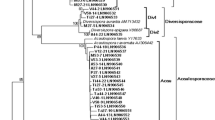Abstract
The community composition of arbuscular mycorrhizal fungi (AMF) was investigated in roots of four different plant species (Inula salicina, Medicago sativa, Origanum vulgare, and Bromus erectus) sampled in (1) a plant species-rich calcareous grassland, (2) a bait plant bioassay conducted directly in that grassland, and (3) a greenhouse trap experiment using soil and a transplanted whole plant from that grassland as inoculum. Roots were analyzed by AMF-specific nested polymerase chain reaction, restriction fragment length polymorphism screening, and sequence analyses of rDNA small subunit and internal transcribed spacer regions. The AMF sequences were analyzed phylogenetically and used to define monophyletic phylotypes. Overall, 16 phylotypes from several lineages of AMF were detected. The community composition was strongly influenced by the experimental approach, with additional influence of cultivation duration, substrate, and host plant species in some experiments. Some fungal phylotypes, e.g., GLOM-A3 (Glomus mosseae) and several members of Glomus group B, appeared predominantly in the greenhouse experiment or in bait plants. Thus, these phylotypes can be considered r strategists, rapidly colonizing uncolonized ruderal habitats in early successional stages of the fungal community. In the greenhouse experiment, for instance, G. mosseae was abundant after 3 months, but could not be detected anymore after 10 months. In contrast, other phylotypes as GLOM-A17 (G. badium) and GLOM-A16 were detected almost exclusively in roots sampled from plants naturally growing in the grassland or from bait plants exposed in the field, indicating that they preferentially occur in late successional stages of fungal communities and thus represent the K strategy. The only phylotype found with high frequency in all three experimental approaches was GLOM A-1 (G. intraradices), which is known to be a generalist. These results indicate that, in greenhouse trap experiments, it is difficult to establish a root-colonizing AMF community reflecting the diversity of these fungi in the field roots because fungal succession in such artificial systems may bias the results. However, the field bait plant approach might be a convenient way to study the influence of different environmental factors on AMF community composition directly under the field conditions. For a better understanding of the dynamics of AMF communities, it will be necessary to classify AMF phylotypes and species according to their life history strategies.





Similar content being viewed by others
References
Ahulu EM, Gollotte A, Gianinazzi-Pearson V, Nonaka M (2006) Cooccurring plants forming distinct arbuscular mycorrhizal morphologies harbor similar AM fungal species. Mycorrhiza 17:37–49
Altschul SF, Madden TL, Schaffer AA, Zhang JH, Zhang Z, Miller W, Lipman DJ (1997) Gapped BLAST and PSI-BLAST: a new generation of protein database search programs. Nucleic Acids Res 25:3389–3402
Bidartondo MI, Redecker D, Hijri I, Wiemken A, Bruns TD, Dominguez L, Sersic A, Leake JR, Read DJ (2002) Epiparasitic plants specialized on arbuscular mycorrhizal fungi. Nature 419:389–392
Börstler B, Renker C, Kahmen A, Buscot F (2006) Species composition of arbuscular mycorrhizal fungi in two mountain meadows with differing management types and levels of plant biodiversity. Biol Fertil Soils 42:286–298
Clapp JP, Young JPW, Merryweather JW, Fitter AH (1995) Diversity of fungal symbionts in arbuscular mycorrhizas from a natural community. New Phytol 130:259–265
Colwell RK (2005) EstimateS: statistical estimation of species richness and shared species from samples. Version 7.5
Colwell RK, Mao CX, Chang J (2004) Interpolating, extrapolating, and comparing incidence-based species accumulation curves. Ecology 85:2717–2727
Daniell TJ, Husband R, Fitter AH, Young JPW (2001) Molecular diversity of arbuscular mycorrhizal fungi colonising arable crops. FEMS Microbiol Ecol 36:203–209
Dickie IA, Avis PG, McLaughlin DJ, Reich PB (2003) Good-Enough RFLP Matcher (GERM) program. Mycorrhiza 13:171–172
Gollotte A, van Tuinen D, Atkinson D (2004) Diversity of arbuscular mycorrhizal fungi colonising roots of the grass species Agrostis capillaris and Lolium perenne in a field experiment. Mycorrhiza 14:111–117
Helgason T, Daniell TJ, Husband R, Fitter AH, Young JPW (1998) Ploughing up the wood-wide web. Nature 394:431–431
Helgason T, Merryweather JW, Denison J, Wilson P, Young JPW, Fitter AH (2002) Selectivity and functional diversity in arbuscular mycorrhizas of co-occurring fungi and plants from a temperate deciduous woodland. J Ecol 90:371–384
Hempel S, Renker C, Buscot F (2007) Differences in the species composition of arbuscular mycorrhizal fungi in spore, root and soil communities in a grassland ecosystem. Environ Microbiol 9:1930–1938
Hijri I, Sykorova Z, Oehl F, Ineichen K, Mäder P, Wiemken A, Redecker D (2006) Communities of arbuscular mycorrhizal fungi in arable soils are not necessarily low in diversity. Mol Ecol 15:2277–2289
Husband R, Herre EA, Turner SL, Gallery R, Young JPW (2002) Molecular diversity of arbuscular mycorrhizal fungi and patterns of host association over time and space in a tropical forest. Mol Ecol 11:2669–2678
Jansa J, Mozafar A, Anken T, Ruh R, Sanders IR, Frossard E (2002) Diversity and structure of AMF communities as affected by tillage in a temperate soil. Mycorrhiza 12:225–234
Johnson D, Leake JR, Read DJ (2001) Novel in-growth core system enables functional studies of grassland mycorrhizal mycelial networks. New Phytol 152:555–562
Kowalchuk GA, De Souza FA, Van Veen JA (2002) Community analysis of arbuscular mycorrhizal fungi associated with Ammophila arenaria in Dutch coastal sand dunes. Mol Ecol 11:571–581
Oehl F, Sieverding E, Ineichen K, Mäder P, Boller T, Wiemken A (2003) Impact of land use intensity on the species diversity of arbuscular mycorrhizal fungi in agroecosystems of central Europe. Appl Environ Microbiol 69:2816–2824
Oehl F, Sieverding E, Mäder P, Dubois D, Ineichen K, Boller T, Wiemken A (2004) Impact of long-term conventional and organic farming on the diversity of arbuscular mycorrhizal fungi. Oecologia 138:574–583
Oehl F, Redecker D, Sieverding E (2005) Glomus badium, a new sporocarpic mycorrhizal fungal species from European grasslands with higher soil pH. Journal of Applied Botany and Food Quality-Angewandte Botanik 79:38–43
Öpik M, Moora M, Liira J, Kõljalg U, Zobel M, Sen R (2003) Divergent arbuscular mycorrhizal fungal communities colonize roots of Pulsatilla spp. in boreal Scots pine forest and grassland soils. New Phytol 160:581–593
Öpik M, Moora M, Liira J, Zobel M (2006) Composition of root-colonizing arbuscular mycorrhizal fungal communities in different ecosystems around the globe. J Ecol 94:778–790
Pianka E (1970) R-selection and K-selection. Am Nat 104:592–597
Posada D (2004) Modeltest 3.5. Facultad de Biologia, Universidad de Vigo, Vigo, Spain
Read DJ, Birch CPD (1988) The effects and implications of disturbance of mycorrhizal mycelial systems. Proc R Soc Edinb Sect B Biol Sci 94:13–24
Redecker D (2000) Specific PCR primers to identify arbuscular mycorrhizal fungi within colonized roots. Mycorrhiza 10:73–80
Redecker D, Hijri I, Wiemken A (2003) Molecular identification of arbuscular mycorrhizal fungi in roots: perspectives and problems. Folia Geobot 38:113–124
Renker C, Blanke V, Buscot F (2005) Diversity of arbuscular mycorrhizal fungi in grassland spontaneously developed on area polluted by a fertilizer plant. Environ Pollut 135:255–266
Santos JC, Finlay RD, Tehler A (2006) Molecular analysis of arbuscular mycorrhizal fungi colonising a semi-natural grassland along a fertilisation gradient. New Phytol 172:159–168
Scheublin TR, Ridgway KP, Young JPW, van der Heijden MGA (2004) Nonlegumes, legumes, and root nodules harbor different arbuscular mycorrhizal fungal communities. Appl Environ Microbiol 70:6240–6246
Schwarzott D, Walker C, Schüβler A (2001) Glomus, the largest genus of the arbuscular mycorrhizal fungi (Glomales), is nonmonophyletic. Mol Phylogenet Evol 21:190–197
Smith SE, Read DJ (1997) Mycorrhizal symbiosis, 2nd edn. Academic, USA
Swofford DL (2001) PAUP*. Phylogenetic analysis using parsimony (*and other methods). Sinauer Associates, Sunderland, Massachusetts
Sýkorová Z, Wiemken A, Redecker D (2007) Co-occurring Gentiana verna and Gentiana acaulis and their neighboring plants in two Swiss upper montane meadows harbor distinct arbuscular mycorrhizal fungal communities. Appl Environ Microbiol 73:5426–5434 DOI 10.1128/AEM.00987-07
ter Braak CFJ, Smilauer P (2004) CANOCO reference manual and CanoDraw for Windows user’s guide: software for canonical community ordination (version 4.5). Biometris, Wageningen, Netherlands; Ceske Budejovice, Czech Republic
Vandenkoornhuyse P, Husband R, Daniell TJ, Watson IJ, Duck JM, Fitter AH, Young JPW (2002) Arbuscular mycorrhizal community composition associated with two plant species in a grassland ecosystem. Mol Ecol 11:1555–1564
Vandenkoornhuyse P, Ridgway KP, Watson IJ, Fitter AH, Young JPW (2003) Co-existing grass species have distinctive arbuscular mycorrhizal communities. Mol Ecol 12:3085–3095
White TJ, Bruns T, Lee S, Taylor J (1990) Amplification and direct sequencing of fungal ribosomal RNA genes for phylogenetics. In: White TJ (ed) PCR protocols, a guide to methods and applications. Academic, pp 315–322
Wubet T, Weiss M, Kottke I, Oberwinkler F (2003) Morphology and molecular diversity of arbuscular mycorrhizal fungi in wild and cultivated yew (Taxus baccata). Canadian Journal of Botany-Revue Canadienne De Botanique 81:255–266
Wubet T, Weiss M, Kottke I, Teketay D, Oberwinkler F (2004) Molecular diversity of arbuscular mycorrhizal fungi in Prunus africana, an endangered medicinal tree species in dry Afromontane forests of Ethiopia. New Phytol 161:517–528
Wyss P, Boller T, Wiemken A (1991) Phytoalexin response is elicited by a pathogen (Rhizoctonia solani) but not by a mycorrhizal fungus (Glomus mosseae) in soybean roots. Experientia 47:395–399
Acknowledgment
We would like to thank S. Appoloni, S. Agten, and T. Gross for conducting some lab and field work, B. Börstler for analyzing several FS and critical reading of the manuscript, I. Hijri, P. Raab, and F. Oehl for practical advice, O. Thiéry for critical reading of the manuscript, I. Jansová and T. Wohlgemuth for advice with multivariate analyses, T. Brodbeck for help with plant identification, and G. Busco for cutting the BP assay bottles. This work was funded by grants by the Swiss National Science Foundation (D.R.) and also supported in part by a scholarship given by the Freiwillige Akademische Gesellschaft, Basel to Z.S.
Author information
Authors and Affiliations
Corresponding author
Electronic supplementary material
Below is the link to the electronic supplementary material.
Supplementary Tables and Figures
(DOC 1.6 mb)
Rights and permissions
About this article
Cite this article
Sýkorová, Z., Ineichen, K., Wiemken, A. et al. The cultivation bias: different communities of arbuscular mycorrhizal fungi detected in roots from the field, from bait plants transplanted to the field, and from a greenhouse trap experiment. Mycorrhiza 18, 1–14 (2007). https://doi.org/10.1007/s00572-007-0147-0
Received:
Accepted:
Published:
Issue Date:
DOI: https://doi.org/10.1007/s00572-007-0147-0




